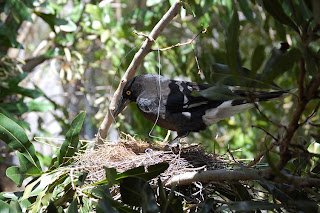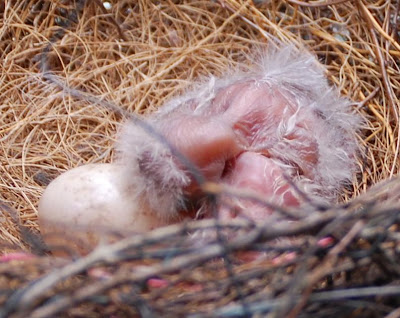In late October, as I was spring cleaning the bathroom, I opened the window and noisily vacuumed the gauze before realising that on the other side of the grime was a very non-plussed mother bird, little more than a metre away!
After we both recovered from shock, I investigated further. The bird was a Pied Currawong and the nest was constructed from sticks, coat hangers and insulated wire. One piece of wire formed a loop like the handle of a basket, helping to secure it to the tree! (Click to enlarge images).
Once the eggs were laid, the nest was rarely unattended. The partner brought meals to the sitting currawong. Which was the Daddy? I wasn't sure. Perhaps they took turns sitting on the eggs.
3 November was a hot day in Sydney. "Curry" as we came to call her, looked very hot sitting in direct sunlight on a day that reached 30 degrees. I took a chance that she wouldn't freak out and used a spritzer bottle to send a cool mist over the nest. She didn't fly away and although I still got "the frown" I think my actions were appreciated or at least tolerated.
On 8 November there were excited cries from the kids' bedroom as they spotted a newborn chick in the nest. Make that two chicks, and one unhatched egg.
DAY ONE - 8 November
On their first day of life, a cool and overcast day, the chicks did very little. It seemed that their only ability was to lift their heads slightly and open their beaks. They seemed to do this at random. It's not a bad talent to have when all you need to do is wait for the delivery of food.
This photo shows the tiny size of the newborn chick next to the parent Currawong.
DAY TWO - 9 November
On their second day of life, the chicks slept a lot and occasionally practised random neck lifting.
The parents alternated between gathering food and sitting on the chicks to protect them, both from the weather and the strange creature in the bathroom (me!).
Feeding continued. Both parents were involved and kept busy by two hungry mouths. Perhaps they were relieved the third egg hadn't hatched into another mouth to feed. At some point, the third egg vanished. It may have been pushed out of the nest once the parents realised it was unviable but we never found broken shell evidence on the ground.
I'm not sure what's on the menu. A worm? Some sticky stuff? But the chicks got stronger. Just look at how they could lift their necks on Day Three.
Day four saw more exercise:
More sleep:
And more frowning at the photographer!
DAY NINE - 16 November
By Day Nine the chicks have started to develop feathers in place of fluff. Their neck lifting is no longer random. Now they only do it when they think food is arriving.
But while their eyes seem to be taking more shape, they still haven't opened them. So how do they know food is on its way? I noticed that they responded to the noise of the parent arriving. They also lifted their heads if the branch they were on moved, either from the wind, or from a certain photographer easing the branch downwards for a look inside! But I didn't do this very often and the open beaks were mostly rewarded with some food.
Day Nine was also the first hot day the chicks had experienced, with a top of 27.6 degrees, compared to mostly low 20s. Instead of sitting directly on the chicks, Curry stood above them to create shade, while having no protection herself. But it was to get a lot hotter, with top temperatures of 33, 31 then 40 on the 20-23 November.
DAY TWELVE - 19 November, 26.5 degrees
The heatwave begins and Curry gets a cool spritz while she protects her chicks.
The heat is so debilitating the chicks lie draped over the edge of the nest. Both Curry and the chicks got a cool spray this day.
More heat, more spray. While in the nest, the young birds get no liquid to drink (other than the juicy insides of worms and bugs).
In general, hot birds will open their beaks as a way to cool down. These three seemed quite keen to drink the moisture coming from the spritzer bottle and I think that without it they could have died from dehydration.
DAY SIXTEEN - 23 November
By dusk on Day Sixteen, a cold change came through and the chicks relaxed while mum went in search of food and water. Sometime during the hot days, the chicks opened their eyes for the first time. All the better to glare at me!
By Day Twenty there was a new exercise regime: wing stretching!
Something was wrong with the left eye of one of the chicks. We had called them Rogan Josh and Vindaloo but there had been no way of telling them apart before this incident.
DAY TWENTY-SIX - 3 December
The eye had closed right over and I asked for advice from a wildlife carer. A vet was recommended, but for that I would need to catch the bird! The nest was close enough to the window for great photo opportunities but just too far away to safely grab the chick. Any attempt to do so could have seen the healthy chick leaping in fear to its death so I did nothing and let nature take its course.
The chicks continued to grow strong and started using their legs!
Quite unexpectedly, the troubled eye has healed. I'm not even sure which chick is Rogan Josh anymore. Both left eyes look good to me.
DAY THIRTY-ONE - 8 December
At 2:46pm I took this photo of both chicks standing, one of them on a branch outside the nest.
DAY THIRTY-THREE - 10 December
At 2:46pm I took this photo of both chicks standing, one of them on a branch outside the nest.
At 9:06am the nest was empty! What had happened? Surely the chicks weren't ready to fly? Had they succumbed to predators? Had their short steps outside the nest caused them to fall to their death?
There was no sign of the birds having fallen. I thought I could hear one calling but couldn't see it before I had to leave for the day. When I returned after school with the kids, we found a chick on the ground. This is not a good place to be for a young, flightless bird. If it stayed there overnight, it could fall prey to foxes or cats.
Curry seemed aware of the problem too. She couldn't lift her chick back up to the nest. All she could do was keep a watchful eye.
Meanwhile, I hatched a cunning plan. Unable to reach the nest, I created a bridge from the bathroom window to the nest. I got a sill box for plant pots from my balcony and lined it with newspaper then hung it over the branch.
Next, I went to the neighbour's house with a towel to help seize the chick. The neighbours weren't home so I went around the side of their house to the back yard. My kids thought this was a risky thing to do but I pointed out we were on a rescue mission and that nobody would mind. I threw the towel over the chick and picked it up. It felt so soft and fragile. Keeping the chick's head covered I carried it up through the house to the bathroom and placed it into the plant holder.
I wasn't sure if the chick could get from the sill box to the nest but at least it was up off the ground and out of harm's way.
To my surprise, sometime in the next 20 minutes, the chick disappeared again. It had gone beyond the nest to another branch and there it continued to be fed by the parents. The other chick was higher up in the same tree and our rescue was a success.
Over the next few days, the chicks moved to different branches and within a week they had left their home tree entirely.
More information about currawongs is available here:
Click link to listen to the sound of a currawong














































